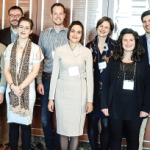We were impressed by the researchers at NIAMS who identified new disease mechanisms by studying rare diseases; we admired the balance of clinical practice and research at the Johns Hopkins University; and we marveled at the close teamwork of world-famous experts at the Feinstein Institute. Most striking of all, and common to all aspects of our journey, was the enthusiasm for mutual learning underscored by the importance of savoring continental difference.
How to Measure the Success of the Program?
Apart from the clear individual benefits, a program supported by the ACR and EULAR needs to pay off for the wider rheumatology community. We, therefore, asked ourselves what the benefits of the AEEP might be, how they could be measured, and when they might become evident. These questions need to be addressed thoroughly, especially in these times of austerity. In a recent editorial, Drs. Randy Cron and Hendrik Schulze-Koops evaluated the long-term benefits of the AEEP.1 Among their evidence to support the program were more than 40 publications emerging from intracontinental collaborations between former AEEP participants as well as another 40 manuscripts deriving from intercontinental AEEP collaborative efforts. Drs. Cron and Schulze-Koops also observed that, so far, many of the AEEP “junior” faculty participants have proceeded to rheumatology directorships in the U.S. and Europe.
When it comes to short-term effects of the program, objective measures are barely available and it is up to us, the participants, to collect pieces of evidence that the AEEP has positive impact on our careers and the community.2,3 This evidence will include recent advances in our research projects or new collaborations set up during the program. In addition to research collaborations, the AEEP is likely to help in laying the groundwork for accruing patients for cross-continental clinical trials. Invited talks and literature reviews are other subtle signs that the AEEP does have these short-term benefits.
Thus, we conclude that the AEEP may indeed have measurable benefits for both the participants and the community. We are sure that the AEEP will shape our future careers and we believe that the AEEP is a future investment of the rheumatology community that will prove its worth many times over. We would like to thank both the ACR and EULAR for reviving this unique platform for transatlantic research exchange. Finally, we would like to strongly encourage both junior and senior physician-scientists from North America and Europe to participate in this exceptional program.


